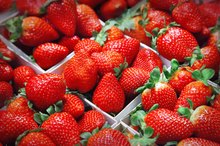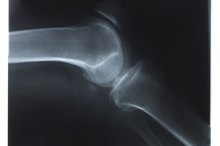Over-the-Counter Medications for Gout
Gout, a painful form of arthritis previously one of the diseases of the wealthy and the royals, has become widespread due to current eating habits that include a diet high in animal fats and animal flesh. Often the first symptom of gout appears in the joints of the big toe as excruciating, burning, tearing pain with angry red swelling and inflammation, disabling the individual. The variety of self-treatments for gout run from conventional painkillers to alternative remedies and common foods. Read on for a list of ways to help cure the pain of gout.
If you are experiencing serious medical symptoms, seek emergency treatment immediately.
Non-steroidal Anti-inflammatory Medicines
Also referred to as NSAIDs, these medicines are available over the counter in pharmacies and grocery stores. They do not prevent the damage to the joints from advanced gout and are used to control pain. Nathan Wei, MD , a nationally known board-certified rheumatologist and author of the “Second Opinion Arthritis Treatment Kit,” urges caution when using NSAIDs because of side effects, such as:
- heartburn
- ulcers
- bleeding [2](# 'inline-reference::“Second Opinion Arthritis Treatment Kit”
- Nathan Wei
- 2009')
Their action prevents blood from clotting, and they can interfere with blood-thinning medications. NSAIDs help reduce swelling and pain in lower doses. Common names of over-the-counter medicines are Motrin, Advil and Aleve.
- Also referred to as NSAIDs, these medicines are available over the counter in pharmacies and grocery stores.
- Nathan Wei, MD , a nationally known board-certified rheumatologist and author of the “Second Opinion Arthritis Treatment Kit,” urges caution when using NSAIDs because of side effects, such as: * heartburn
* ulcers
* bleeding 2 Their action prevents blood from clotting, and they can interfere with blood-thinning medications.
Topical Applications
How to use Epson Salt for Gout
Learn More
Capsaicin cream, made from the active ingredient in chili peppers, is available in a topical application and has been shown to reduce painful symptoms of gout. It binds to pain receptors in the joint, reducing the sensitivity to stimuli. Dr. Robert W. Griffish notes that researchers at Oxford University in England have reported on the safety and efficacy of using Capsaicin cream for gout.
Foods as Gout Remedies
Black bean broth is rich in anthocyanins, which are natural anti-inflammatory agents found in tart cherries and black beans. A common gout pain remedy, black bean broth has been found effective by many readers of GoutPal.com 1. Easy to make, the recipe from GoutPal.com follows 1.
Use turtle or soy beans. “Rinse 200 grams (7 ounces) beans and remove any grit or other debris. Cover with 2 liters water and bring to the boil. Reduce heat, and simmer for 90 minutes. Strain the liquid, which is what you drink, and throw away the beans. Allow to cool, and gulp down about 1/2 liter of the broth.” Take this at the first signs of a gout attack.
Tart cherry juice has been found to be very effective as an over-the-counter treatment for gout. An anti-inflammatory rich in antioxidants, cherries can be consumed not only as cherry juice but in raw or canned form and will reduce painful gout symptoms.
- Black bean broth is rich in anthocyanins, which are natural anti-inflammatory agents found in tart cherries and black beans.
- An anti-inflammatory rich in antioxidants, cherries can be consumed not only as cherry juice but in raw or canned form and will reduce painful gout symptoms.
Related Articles
References
- GoutPal.com
- “Second Opinion Arthritis Treatment Kit”, Nathan Wei, 2009
- U.S. Department of Health and Human Services and U.S. Department of Agriculture. 2015–2020 Dietary Guidelines for Americans. 8th Edition. Published December 2015.
- U.S. Department of Health and Human Services. Gripped by Gout. NIH News in Health. Published February 2014.
- National Institute of Arthritis and Musculoskeletal and Skin Diseases. Gout. Updated April 2016.
- Zhang Y, Chen C, Choi H, et al. Purine-rich foods intake and recurrent gout attacks. Ann Rheum Dis. 2012; 71(9):1448-53. doi:10.1136/annrheumdis-2011-201215
- Fischer E. Ueber die Harnsauer. 1 [On Uric Acid. 1]. Berichte der Deutschen Chemischen Gesellschaft. 1884: 17:328-338. doi:10.1002/cber.18980310304
- Ragab, G., Elshahaly, M., & Bardin, T. (2017). Gout: An old disease in new perspective – A review. Journal of Advanced Research, 8(5), 495–511. doi:10.1016/j.jare.2017.04.008
- Centers for Disease Control and Prevention. Gout. Updated January 28, 2019.
- Zgaga, L., Theodoratou, E., Kyle, J., Farrington, S. M., Agakov, F., Tenesa, A., … Campbell, H. (2012). The Association of Dietary Intake of Purine-Rich Vegetables, Sugar-Sweetened Beverages and Dairy with Plasma Urate, in a Cross-Sectional Study. PLoS ONE, 7(6), e38123. doi:10.1371/journal.pone.0038123
- Choi HK, Gao X, Curhan G. Vitamin C intake and the risk of gout in men: a prospective study. Arch Intern Med. 2009;169(5):502–507. doi:10.1001/archinternmed.2008.606
- Zhang Y, Neogi T, Chen C, Chaisson C, Hunter DJ, Choi HK. Cherry consumption and decreased risk of recurrent gout attacks. Arthritis Rheum. 2012;64(12):4004–4011. doi:10.1002/art.34677
- Arthritis Foundation. Gout Diet: Dos and Don’ts.
- Boban M, Modun D. Uric acid and antioxidant effects of wine. Croat Med J. 2010;51(1):16–22. doi:10.3325/cmj.2010.51.16
- Caliceti C, Calabria D, Roda A, Cicero AFG. Fructose Intake, Serum Uric Acid, and Cardiometabolic Disorders: A Critical Review. Nutrients. 2017;9(4):395. Published 2017 Apr 18. doi:10.3390/nu9040395
- U.S. Department of Health and Human Services and U.S. Department of Agriculture. 2015–2020 Dietary Guidelines for Americans. 8th Edition. Published December 2015.
- U.S. Department of Health and Human Services. Gripped by Gout. NIH News in Health. Published February 2014.
- Kakutani-Hatayama M, Kadoya M, Okazaki H, et al. Nonpharmacological Management of Gout and Hyperuricemia: Hints for Better Lifestyle. Am J Lifestyle Med. 2015;11(4):321–329. Published 2015 Sep 2. doi:10.1177/1559827615601973
Writer Bio
Susan Kaye writes about alternative health care, the medicinal value of foods and natural remedies for healing body, mind and spirit. She is currently retired from an active classical homeopathy practice and enjoys sharing her passion for alternative medicine in her writing with those seeking health care freedom.








